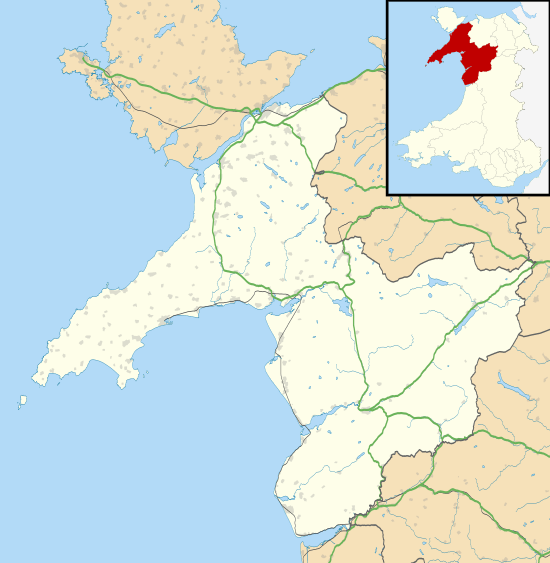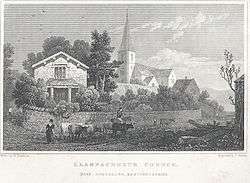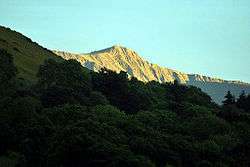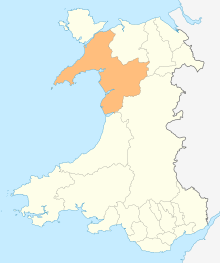Llanfachreth
Llanfachreth is a settlement some three miles north-east of Dolgellau (its post town), in the community of Brithdir and Llanfachreth (Population 751 in 2011) within the historic boundaries of Merionethshire (Welsh: Meirionnydd, Sir Feirionnydd., Wales. The village is on the slopes of the valley of the river Mawddach and at the foot of Foel Offrwm and Rhobell Fawr. To the south-west on another prominent hill, the Foel Cynwch, is the famous Precipice Walk.
| Llanfachreth | |
|---|---|
St. Machreth Church, Llanfachreth | |
 Llanfachreth Location within Gwynedd | |
| Population | 200 (2001 census) |
| OS grid reference | SH755225 |
| Community | |
| Principal area | |
| Ceremonial county | |
| Country | Wales |
| Sovereign state | United Kingdom |
| Post town | DOLGELLAU |
| Postcode district | LL40 |
| Dialling code | 01341 |
| Police | North Wales |
| Fire | North Wales |
| Ambulance | Welsh |
| UK Parliament | |
| Senedd Cymru – Welsh Parliament |
|
History and Nannau House
From the 12th century two families, the Nanneys and the Vaughans, controlled the area that formed the greater part of the parish of Llanfachreth. The estate was, and is, known as the Nannau estate.[1] The history of Llanfachreth is inextricably intertwined with the fortunes of these families. Cadwgan, son of Bleddyn ap Cynfyn, Prince of Powys in the early 12th century, came into possession of large areas in Merioneth and built Nannau house, a mansion a mile south west of Llanfachreth, which Obert Vaughan of Hengwrt (1592? To 1667) later called the stateliest structure in North Wales.[2] Cadwgan founded a small colony of serfs at Llanfachreth[3] and his free followers settled the lands surrounding the house. The settlements spread over the area of Llanfachreth and became arable holdings made up of 70 tyddynod. Cadwgan was killed at Welshpool in 1111 but his lands remained in his family until 1701.[4]
Of the descendants of Cadwgan some are documented. His great great grandson, Ynyr Vychan, in the early 14th century cooperated with the Edwardian regime which ensured his family served in local offices where otherwise English were engaged. Despite a later colourful feud with the Owens of Llwyn family of Dolgellau the family held offices and bought land thus maintaining the estate. After provocation and a lawsuit in 1603 Huw Nanney marched from Nannau to Dolgellau, entered the church and destroyed the pew of the Owens family, a deadly insult. This and other acts such as cutting down thousands of (royal) oaks in an attempt to get himself out of financial difficulty actually landed him in prison but, after he petitioned a reduction of his fine from £1000 to £800 and paying it he then, at the age of over 60, in 1612 rebuilt Nannau to a staggeringly expensive standard. The house was rebuilt again in 1693 by colonel Huw Nanney but, after his death, the estate fell from direct male inheritance to the Vaughan family through Anne his second daughter's daughter who had married her cousin William Vaughan. Robert Howell Vaughan was made a baronet in 1791.
Robert Williams Vaughan, 1768 to 1843, the second baronet, ruled the surrounding countryside with benevolent autocracy for over 50 years.[5] He was affectionately known as "Yr Hen Syr Robert" and, during this golden age of the estate, he rebuilt Nannau between 1788 and 1796, was elected as MP for Merioneth in 1792, and subsequently re-elected thirteen times, sitting till 1836.[6] He accomplished much for the area; along with the rebuilding of nearby Dolgellau he financed much renewal of cottages, enclosure walls, houses, roads, fencing and created the precipice walk on the estate. Much of this work was paid for by Robert to relieve unemployment after the Napoleonic wars. He built several roads from Nannau house and, a mile east of Llanfachreth across the Bontnewydd road, a striking arch called "Y Garreg Fawr" (the Great Stone) because of huge stone, brought from Harlech, that forms the span. Many of the cottages he had rebuilt in Llanfachreth are unusual architecturally. They include slate roofs curving over dormer windows, for instance, and porches with rounded brick pillars. The last he built was "Glasgoed" a mile north of Llanfachreth. The cottage should have been higher on the hill but his health was failing so he had it built where he could see it and oversee its construction from near Nannau House. He was appointed High Sheriff of Merionethshire for 1837–38. After his death in April 1843 he was buried in Llanfachreth churchyard and his descendants took little interest in the estate. This generous man had included meanest of villagers and servants at Bodyrgollan and Rhug, where he also had interests, in his will.
Last to take an active role in the estate was John Vaughan, High Sheriff for 1880–81. He rebuilt farm cottages to a high quality. This, the building of the school and a rent rebate 10% made him very popular. He died in 1900, The estate was left to wife and, in 1917, divided between her sons, the bulk to army General John. It became loaned to the war office as convalescent home for shell shocked veterans between 1918–1921. During the Second World War it sheltered a girls' school from Kent. Gen Vaughan did not live on the estate until late in life. He rebuilt the cottages called Tai-Baldwin in Llanfachreth, improved Bryn Ywen near the church, and converted a barn opposite Hen Felin into an attractive house. High, post war government taxes made further benevolent improvement and maintenance of the estate difficult and the estate was gradually split up. After the General died 1956 there was no direct descendant and Nannau was sold in 1966. In 2013 it again stands empty and for sale. It is a grade II* listed building, one of the highest country houses in the UK.
Church

The church is dedicated to Celtic Saint Machreth. The village name Llanfachreth is derived from the Welsh soft mutation of that saint's name. Until around the 8th century the area was pagan but was Christianised during this time by wandering Celtic monks. The only other dedication to St Machreth is in Anglesea, he was likely a follower of St. Cadfan in the wake of the Cunedda invasion from the South East of Scotland in the 5th century. Alternatively, since there have been no more dedications, St Machreth might have been local holy man or hermit. (prof EGBowen) . Tradition has it that he had a retreat (cell) above the village in a wood locally known as Coed-cwm-yr-Eglwys. The parish of Llanfachreth came under jurisdiction of Cymer Abbey founder and is mentioned in 1243 (RCAM County of Merioneth Vol VI, introduction p xx). There are no other records until 1614 when a commission, set up by post civil war puritans, records eight Merioneth clergy evictable. This included, in 1649, Roberts the curate of Llanfachreth "for leading an unhealthy, adulterous life". On the other hand, one minister, Ellis Osbourne Williams, was so popular that on leaving in 1865 he was gifted £21/16/3. Having no vicarage was very inconvenient especially since Llanelltyd came also under the care of the minister so, around 1844, a vicarage was petitioned and granted at a cost of around £400. The old Llanfachreth church was apparently higher and wider than present one though little is known. The choir sat high in a gallery across the chancel. (Deffroad y Werin, Griffith Price, Cors-y-garnedd, Llanfachreth... 1905, p 141=3)(Possession EWPrice, Dol) Four roads meet by the church and by the early 19th century so many converged that there was insufficient space for the worshippers. (U.C.N.W Nannau MS 714) The generous Sir Robet Williamses Vaughan had the church enlarged. The East wall was extended 18 feet in depth and 25 feet in breadth. The South wall was extended 15 feet in depth and 20 feet in breadth. Also granted by the Bishop of Bangor in 1820 was permission for the South aisle to be erected and the addition of appropriate pews and seating. All permission was granted on the condition that Sir Robert be responsible for maintenance! The South transept was pulled down and rebuilt in 1872 but the tower left intact. The contract cost £1,300 and the architect was Benjamin Ferrey. The church was re-opened 30 April 1873 some 30 years since the funeral of Sir Robert. The tower is interesting as it features an external stairs leading to a separate door for the use of the bell ringer. Within the church there is commemoration to Rice Jones the poet who had "messuages and lands" in the parish and is buried somewhere in the church. The organ was originally powered by water from a reservoir above the church but is now electric. The churchyard is circular, the boundary has changed but ancient yews to the north probably trace the original path boundary before extension. The graveyard is very crowded, mostly with blue/grey slate stones, almost entirely Welsh memorials. There are many interesting and lovely designs the earliest discernible dating 1721. They include such strange memorials as that to Hywel Pugh. He was a farmer who died in 1851 aged 85. An animal doctor (vet) he visited all over the district. The Welsh inscription translates, probably, ” Appeals for help to attend sick animals brought many people to Hywel Pugh. He nursed and gave such help as he could to hundreds, nay to thousands of sick animals". Although most of the graves are Welsh there is, to the north of the yard, the grave of a young English girl which consists of a boulder on which she liked to sit that was removed here from near her home and transcribed, "Melody Tullett of Cors-y-garnedd who made more friends in seventeen years than we can hope to make in a lifespan".
Chapel
Nonconformity was an important issue in the late 18th century. William Evans (Fedew Arian, Bala) preached the first Methodist sermon by Pwllgele Lake in Llanfachreth parish in 1783. At this time the Vaughans were so opposed to alternative ministries that this had to be held in the open air. The first person to let a Methodist minister to preach inside his cottage in this area was Evan James of Ty’n-y-ffridd cottage who was subsequently persecuted for his pains. John Puw next offered his house, a remarkable act since he was the bell ringer for St Mackreth's and subsequently lost that job. Robert Vaughan refused to allow any of the stones or bricks on his estate to be used for the building of a chapel. Methodist representatives travelled to Bala and the wife of the absent Thomas Charles granted permission for stones to be taken and used. In 1804 a new chapel 8 yds x 8 yds. 1868. Cost £160. For a while there was a well close to the village used for baptisms. It consisted of a square recessed wall with steps down to the water and is still existent though disused and loosely covered with corrugated sheets.
The village
The parish of Llanfachreth is quite large and consists of individual homesteads many quite remote. The village itself consists of around 35 to 40 households closely adjacent to the church. Though once there were at least three public houses, a shop and a post office until relatively recently none of these amenities remain, the mobile population mostly replenishing supplies from nearby Dolgellau. Interesting features other than the church and its Lych Gate include a war memorial to local residents who gave their lives in the world wars and a mounting block that once stood at the bottom of the steps to the Lych gate once served as a "town cryer" type of meeting place. The cottage "Ty-isa", opposite the church steps, was previously a pub and brewery. In later temperate times the brewing cauldron was used elsewhere to dip sheep.
Local attractions

The surrounding area is known for its wild but beautiful countryside and places of historical interest. It is popular with tourists who enjoy activities such as walking, hiking, horse riding, white-water rafting and climbing. Nearby Dolgellau is a base for climbers of Cadair Idris (known as Cader Idris locally).
There also the Great Western Railway line from Ruabon to Llangollen was extended via Corwen and Llanuwchllyn to Dolgellau, where it formed an end-on connection with the Cambrian Railways line from Barmouth Junction and a shared station was opened there in 1868. The Ruabon Barmouth line was closed in the 1960s under the Beeching Axe. The railway line was converted some years ago into the Llwybr Mawddach (or "Mawddach Trail") which now runs for some eight miles from Dolgellau to Morfa Mawddach railway station, near Fairbourne on the coast. It is maintained by the Snowdonia National Park and is very popular with walkers and cyclists. It passes some estuarine areas that are important for water birds.
Historical attractions also include the 12th century Cymer Abbey, near to Dolgellau and the market town of Dolgellau itself. Also a mile to the West of Llanfachreth, along the banks of the Mawddach, are nature walks and disused copper mines to explore.
Llanfachreth is a good centre for visiting a number of nearby narrow-gauge heritage railways, including the Corris Railway, the Fairbourne Railway and the Talyllyn Railway. The Center for Alternative Technology is some 20 miles to the south. The village, snuggling in the hills close to the centre of Snowdonia National Park and is in easy reach of The Precipice Walk, the Mawddach river valley and the many footpaths across the nearby hills. Cader Idris is visible, when not in shroud, from there and but a short car drive. The views from the Precipice Walk are well worth the effort. There are several holiday cottages in the area.
The school
Prior to the mid 19th century education for the children of the large parish was haphazard and undertaken by parents, the church or by volunteers and the standard was very low throughout Wales.[7] The first building used in Llanfachreth was a barn. Llanfachreth Church School was built, under the instructions of Robert Wms Vaughan, in 1847. In 1902 a new girls' entrance was built and the playground redivided. In 1903 the Returns and Reports presented to Merioneth County Council still shows "The School House, Dwelling house and playground are the property of Mrs Vaughan, of Nannau, and are let to the managers at a peppercorn rent..."[8] H.M. Inspector's Report for the year 1878 to 79 makes interesting reading;
"This little school has passed a very good examination in the elementary subjects. It is likewise very well conducted. A wider range of subjects including sewing as a specific subject may now be successfully undertaken. Another set of books is required. Fresh maps and coloured cards are wanted for the Infants. ... the whole population within two miles of the nearest road to the school is 315 so that the conditions for a Grant under Act 19 (D) are not satisfied"
Many children had to walk great distances through the parish and, as the log for 31 August 1887 attests, would miss lessons for other reasons... "Only 26 scolars present this morning, the weather being most favourable for the farmers to get their hay in, which was fast spoiling owing to the constant bad weather we have had of late". The school served the community and the parish teaching children between the ages of 3 and 11[9] It closed in 2015.
Famous residents
Rice Jones, 1713–1801, Welsh Bard and historian of great repute. He was the son of John Jones of Blaenau, Llanfachreth and educated first at nearby Dolgellau then Shrewsbury. His works were published in 1818 under the title Gwaith Prydyddawl Y Diweddar Rice Jones o'r Blaenau, Meirion. Gan Rice Jones Owen, Wyr yr Awdur . He died 14 February 1801 and was buried in St. Machreth church.
Gallery
- Llanfachreth Vaughnan Cottages
- Llanfachreth War Memorial
- Llanfachreth Cottages south of Church
- Cottage near church with circular pillars and verandah
- Llanfachreth Old Vicarage
- Llanfachreth site of Babtist Well
- Y Garreg Fawr, Arch entrance to Nannau Estate
- Capel Carmel
- Cottage, once a shop
- St. Mackraeth Tower. Bell Ringers entrance.
- Nannau House near Llanfachreth in 2010
- LLanfachreth, Heulwen Guest House
References
- TP Ellis Tribal Laws and customs of the Middle Ages vol 1 p236
- Notes on the house of Nanney 1649 Arch Cam 1863 p1300
- TPEllisThe Story of Two Parishes
- JE Griffiths pedigreesp200
- J E Griffith, Pedigrees, p200
- "NANNEY ( NANNAU ) family, of Nannau, Mer". The National Library of Wales. Retrieved 14 July 2013.
- Idris Jones, The Modern History of Wales,pp 251 – 2
- County Records office, Dolgellau
- "Archived copy". Archived from the original on 8 June 2011. Retrieved 30 June 2010.CS1 maint: archived copy as title (link)
- Llanfachreth, Bygones of a Merioneth Parish; Mary Corbett Harris (Dolgellau Merioneth County Record Committee, 1973)
Notes
| Wikimedia Commons has media related to Llanfachreth. |
